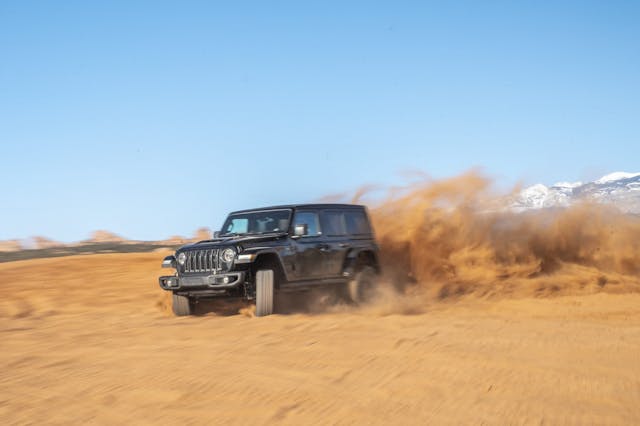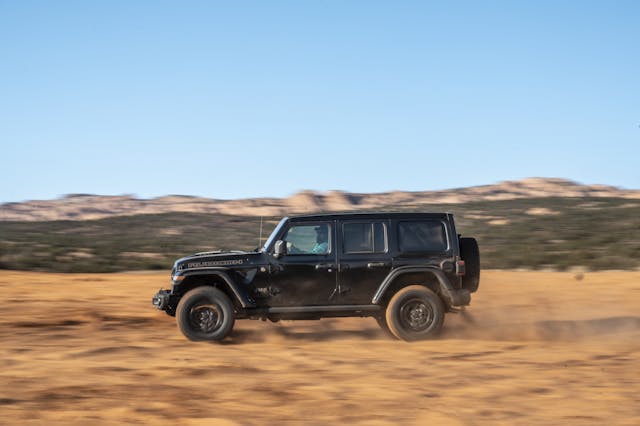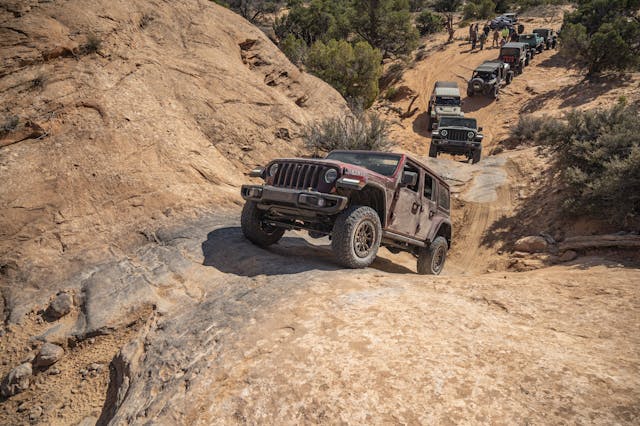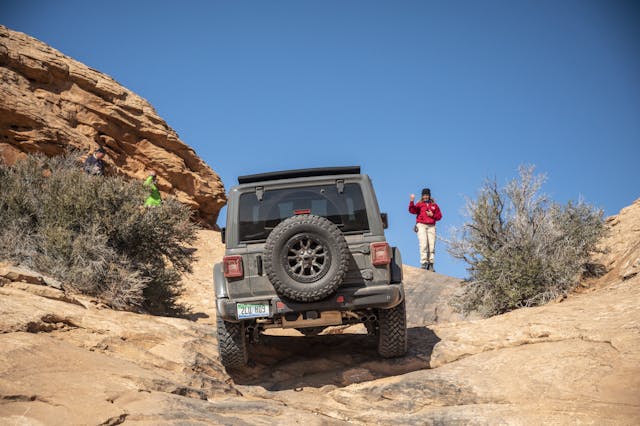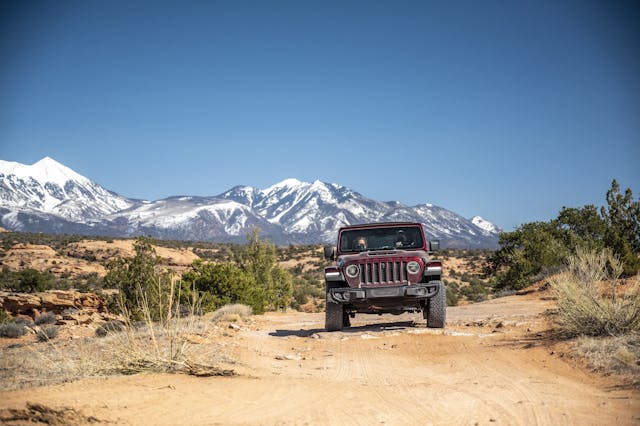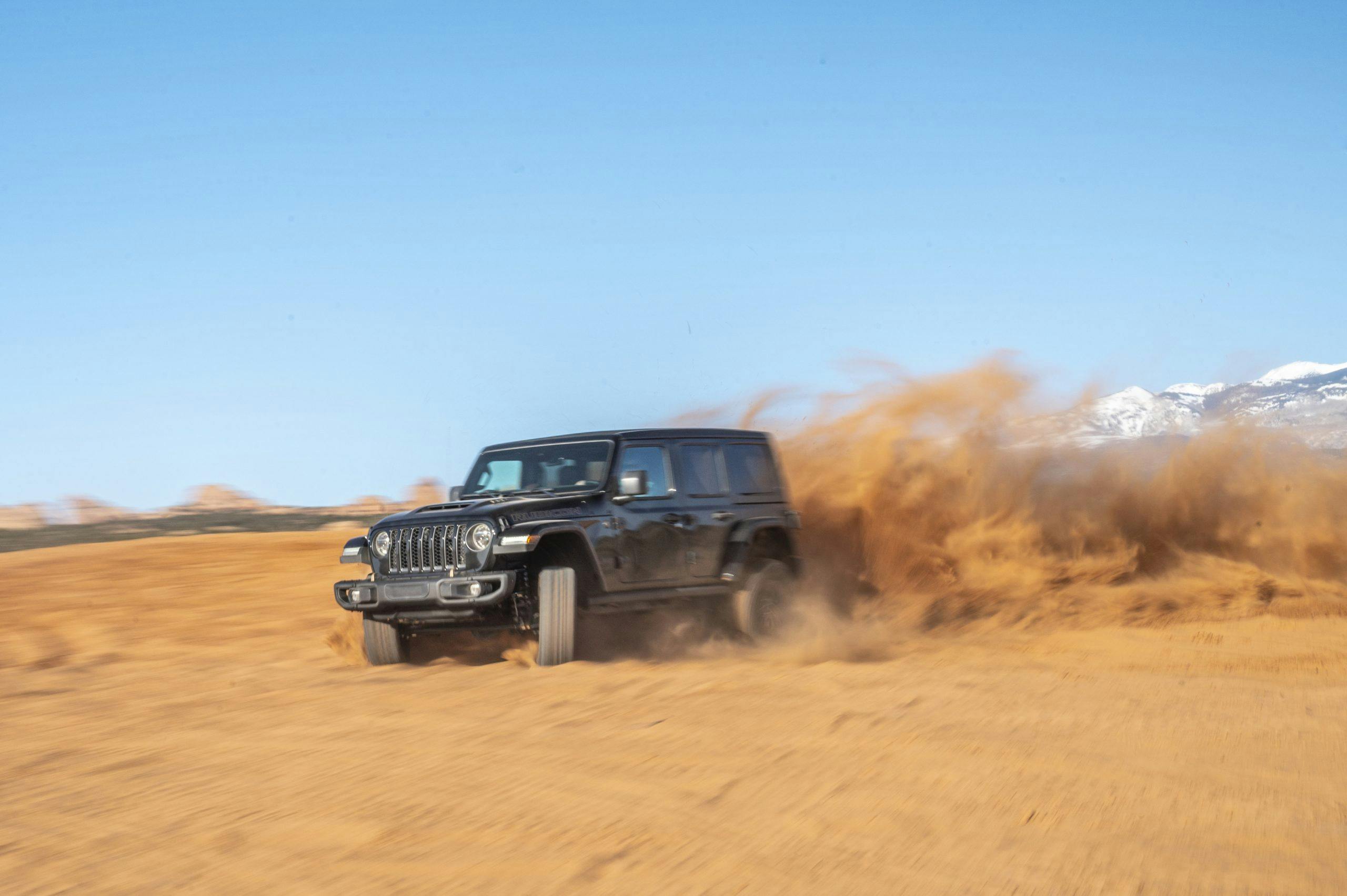Media | Articles
Off-Road Review: 2021 Jeep Wrangler Rubicon 392
It was in the dunes when old habits really started to kick back in. Nothing was standing in the way of a gentle left flick and a quick stab of throttle, floating the Wrangler Rubicon 392 a few feet and steering back right as the muscle-born V-8 wound up to the limiter. The Scandinavians call it a pendulum turn (and we call it the Scandinavian flick) but to a Jeep it’s a fast series of inputs to exploit its weight transfer for what really amounts to pure, unadulterated joy.
With more room to burn than the slick-rock stair steps and two-track trails typically associated with the area, the dunes south of Moab, Utah offer a skid pad of sorts, though one that’s akin to driving on peanut butter. Momentum and tire speed are the recipes to success in the sand, something much to the chagrin of typical vehicle-dynamics engineers. You can slide and pivot this six-foot-tall 4×4 like a rally car, or you can let the transmission shift up and build your momentum for the next obstacle. Let’s do the latter.
Lift, steer, add a bit of throttle back, lift, big steer in the opposite way, and a symphony motivation erupts from behind as all four BFGs pinwheel waves of sand over the Rubicon 392 and it carries over into a comfortable slide. Keep the speed up, with a little help from the massive HEMI, and you might just get third gear. But you have to be on top of things. This isn’t like any previous factory off-road machine I’ve ever driven, all of which eventually let invisible hands decide exactly how much fun was going to be had and/or stepped in to make your ill-planned decision look like a pro-move.
Frankly, there’s nothing quite like it on the market. The Wrangler’s most direct competition is an array of mid-sized pickups and SUVs whose independently-sprung front suspensions pale in comparison to the floating Danas that Jeep so proudly hangs underneath their most diehard machines for trail use. Nor will there be anything like in the market in the years to come; Ford has already stated that it doesn’t intend to throw a V-8 under the Bronco’s hood, leaving us to search for the Rubicon 392’s competition in the wild west: the aftermarket.
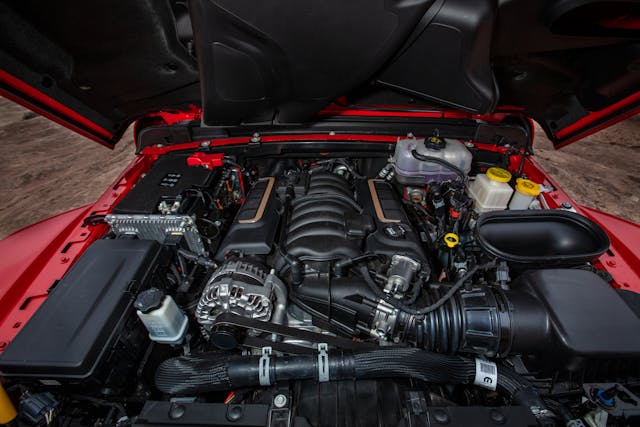
One wonders why it took so long for Jeep to put the V-8 back into its core product; after all, the aftermarket has been doing it for years. Adding insult to injury, the most common choice for a heart transplant behind Jeep’s seven-slot grilles has been the General Motors LS series of aluminum-block engines. These swaps, often totaling tens of thousands of dollars in parts and labor, have long represented a missed opportunity for Jeep to make money. In many cases, they have also lacked the ever-crucial CARB EO number that gave a pathway to emissions-compliancy. By contrast, the Rubicon 392 enters the fray with a factory-backed warranty and no under-the-table antics at the inspection station. The price tag $74,995 (with destination) initially sounds shocking, but in exchange you get the most worry-free V-8 Wrangler experience money can buy.
Marketplace
Buy and sell classics with confidence
It’s also a tightly-engineered package, as we found out in the trails south of Moab, driving more like a dirt-fed Scat Pack 392 than any Jeep we’ve wheeled before. More than just a mere V-8 swap, the Rubicon 392 offers a revised version of the JL’s frame and suspension geometry, reinforcing the rails up front for the Hemi’s grunt while adjusting the rear control arm pickup points for the additional overall ride height needed to clear the deeper oil pan. There are also minor changes to crossmembers to clear the Hemi’s accessory drive, necessitated by the longer engine block. SRT vehicle dynamics manager Erich Heuschele had a hand in refining the spring and shock package, adding his own devil-may-care approach to stability control along the way.
The Wrangler Rubicon 392 Launch Edition features body color flares and hardtop, an 8.4-inch Uconnect infotainment that integrates Jeep’s Off-Road Pages (suited for trail use with inclinometers, front-and-rear camera systems, navigation, and other performance monitoring), plus a leather interior with the cold weather group options ensuring the seats and wheel can be heated. Jeep drips bits of bronze into various logos and elements to mark the Rubicon 392, but it’s the active exhaust system that makes the loudest statement.
To generate that noise, Jeep started with the version of the 392 that was already packaged for its Grand Cherokee SRT. 470 hp and 470 lb-ft of torque are served through the familiar TorqueFlite 8HP75 eight-speed and Selec-Trac. There are no 2WD modes; you’re limited to 4WD High, Neutral, and 4WD Low. While this removes the ability to stand on the brakes and grind the rear set of 33-inch BFGs into the pavement, it does allow all four to hook and offer revolutionary performance for Wrangler buyers: sub-five-second 0-60 sprints and relentless highway acceleration.
Which is the best way to describe the Rubicon 392: absolutely relentless. Need to hop out of a trail directly onto the highway? Drop the foot and watch the massive hoodscoop aim for the sky. Even without the optional 5.48 gears, up-sized tires simply won’t be a penalty. The TorqueFlite’s programming keeps RPM right at the base of the torque curve, giving the Rubicon 392 a responsive feel. With the transfer case in 4-auto, and Off Road+ disabled, Jeep tunes the powertrain for a snappy response in the streets, especially with the active exhaust system opened up. As with many off-road havens, Moab’s elevation changes can be brutal for many powertrains, as the steep climbs and lack of air density work to suck the performance out of naturally aspirated setups, but the 392 hardly notices, still able to bark the tires on command. This should also surprise no one; V-8 swaps have predictable outcomes. More of a surprise: just how predictable and useful the powertrain is both off and on the road.
With the transfer case slid down-and-right for 4-low, the throttle is totally remapped to emphasize low-speed modulation, while the transmission is perfectly willing to find the lowest gear possible and rip all four tires across the dirt. Engine braking can be precisely selected via any of the eight ratios provided by the TorqueFlite, and the 392 made crawling no-drama thanks to the 48:1 crawl ratio (less aggressive than the V-6 Rubicon’s 77:1/84:1 auto/manual crawl ratio) doling out the available torque. In practice, it all comes together without any need to dial in various settings or dig through system menus to activate features. Off Road+ is the only real button press needed after dropping the transfer case down into either 4-high or 4-low, and from there, the work by calibration engineers at Jeep and SRT shines in its predictable response to any given situation.
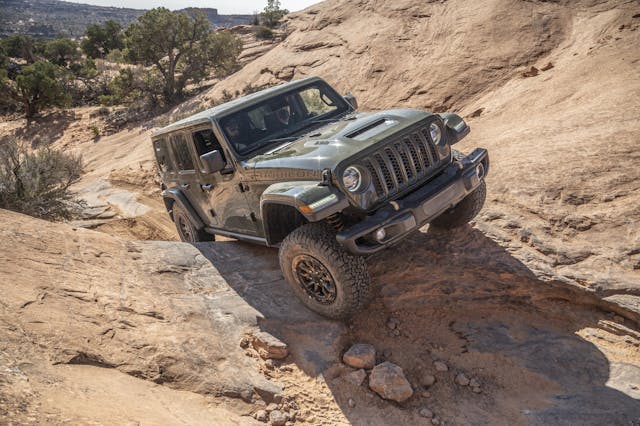
Our route through Moab offered a mix of the region’s trails, starting with rocky, low-line washes before crawling along slick rock stair steps and eventually meandering to the dunes. The engine was the center of attention at first, barking and clawing across the dirt, but quickly it’s the chassis that starts to stand out. It has theoretical potential to easily become a handful. There’s more than enough power to quickly rotate the Wrangler on-command, but where one might expect the consequences of a tall-riding SUV on low-pressure tires to come into effect, SRT’s polished suspension tuning shines. At medium and higher speeds, those SRT roots show thanks to the incredible control over the axles by the factory-tuned FOX shocks. In whoops and washboards, axle hop is tamed, giving it a planted feeling that the tires aren’t dancing over the tops of each bump. When given the space, weight transfer at higher speeds is predictable and exploitable, encouraging Scandinavian flicks that can result in and endless string of transitions with the power on-tap to maintain a graceful slide.
Mistakes are forgiven too, there’s enough travel and damping to soak up ruts and missed bumps, resisting the urge falling into any bucking motions that would assuredly upset the tall, 4×4 chassis. Between the stair-steps and rock gardens, it could be treated as much as a rally car as anything else, forgetting that you’re sitting twice as high. And like all good enthusiast machines, if you’ve turned off traction and stability controls, they’re truly off—the Rubicon 392 does all that you ask of it, and nothing more. If you’re not on your game, it’ll find the fastest way to trouble, but until then, it predictably will always have power there for you, let a slide be carried until its ultimate fates, and permit finessed left-foot braking without throttle cuts, leaving you to dial in any creative solution you want in the moment. Sure, there are extra features like Selec-Speed Control for automatic throttle and braking, and Off Road+ has additional modes for Sand and Rocks, it’s just that nothing replaces the simplicity of a 4×4 that only concerns itself with what the driver tells it through the wheel and pedals.
Adding in the fact that the doors, roof, and windshield are also removable, it’s a modern marvel that this Jeep even made it past the suits and regulators. Had there been any meddling with this purist approach to off-road driving, an indifference to the cries of enthusiasts and experts in the off-roading community for the comfortable suggestions of some liability department, the Wrangler 392 could’ve stumbled into our hands as a lifestyle facade—like so many other late-model 4×4 packages.
It’s the Wrangler with no shortage of power, like the V-8 swapped Miata of today’s 4x4s. It’s taken what owners have loved about the platform and sought to simply enhance it. Given the huge juxtaposition between the Wrangler’s many intended uses, it could have opened up the platform for some ill-conceived behavior, leaving each trip a white-knuckle experience that drains away confidence. Perversely, it encourages bad behavior, whispering to you that the axles have more articulation in them, that you can stay in the throttle longer as the suspension soaks up faster and faster impacts, and no rev-limiter should be feared as it’s just a tool for wheel speed—and the worst case? The warranty department handles it—something a little tough to do with an aftermarket V-8 swap.
2021 Jeep Wrangler Rubicon 392
Price: $74,995 (including $1495 destination)
Highs: The Wrangler everyone has been wanting after the V-8’s departure 40 years ago, brisk performance on the street that’s well-tamed when required off-road, the 392’s rumble.
Lows: While it offers a great value given the aftermarket alternatives, the price hasn’t exactly scaled up with inflation from its CJ-forefathers, leaving the barrier to entry for all but the most die-hard, and affluent, Wrangler buyers. Fuel economy? Well, the EcoDiesel is positioned as the solution for pump price-sensitive buyers.
Summary: Knowing what it does best, Jeep built the ultimate Wrangler for its buyers. There will still be aspects of the Wrangler platform that won’t please everyone, it’s not a plush ride and the cabin is cozy if tight for some body types. But without explicitly calling it a solution to both a Raptor and Bronco, the Rubicon 392 leaves little else to desire for those who still focus on rock-crawling performance across the nation’s toughest trails but want something that finds itself still comfortable at high speeds, both on- and off-road.
